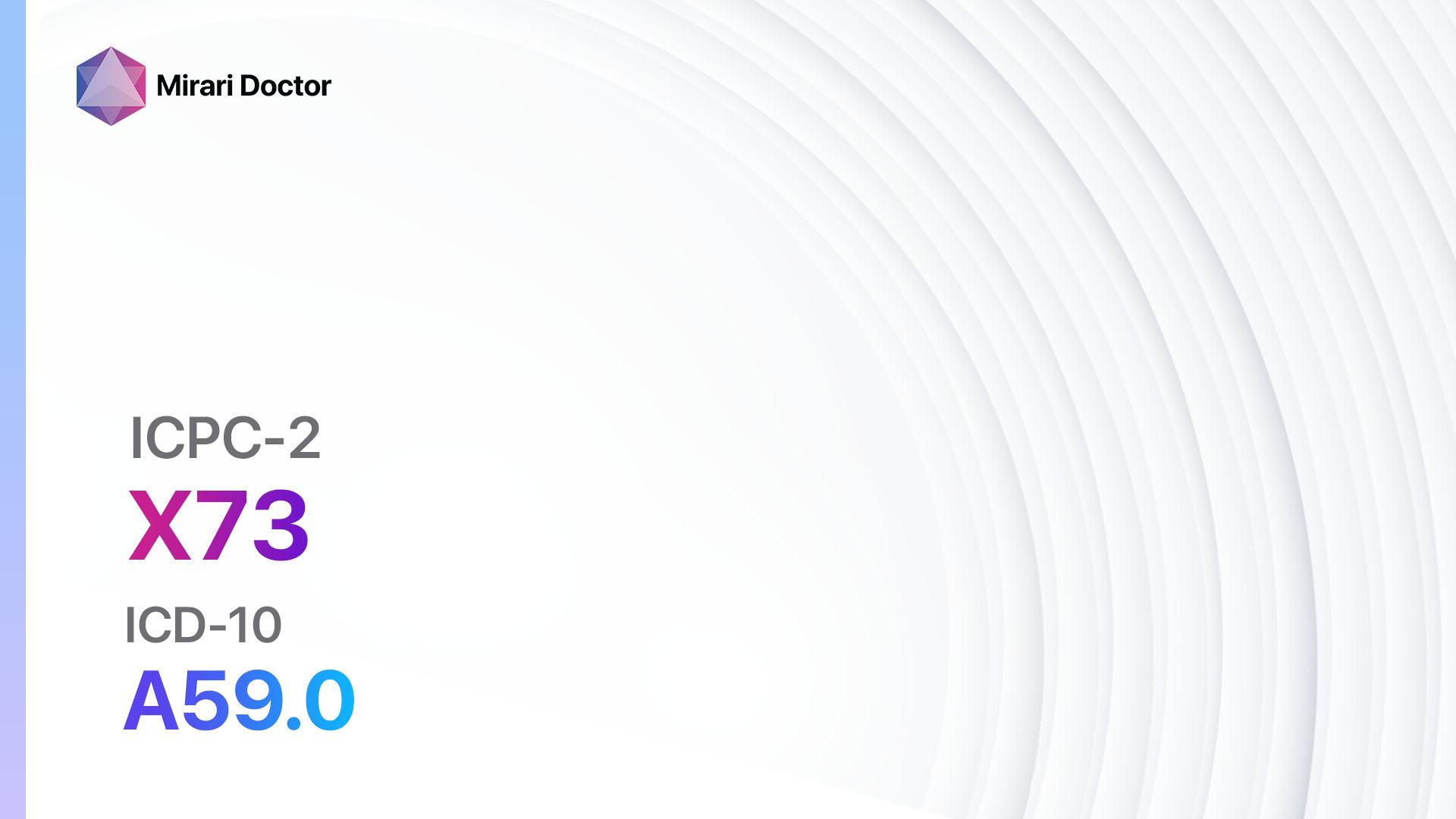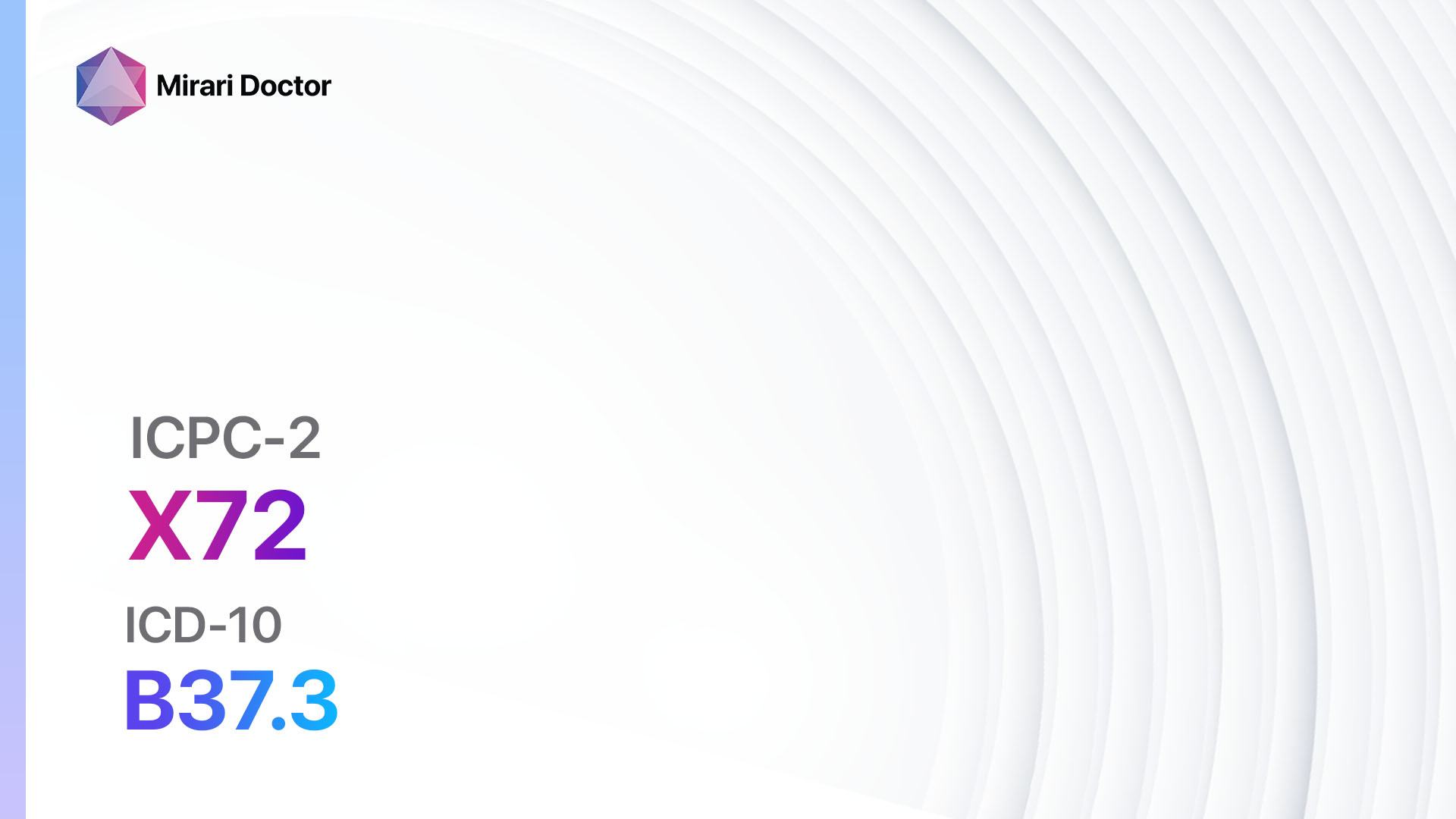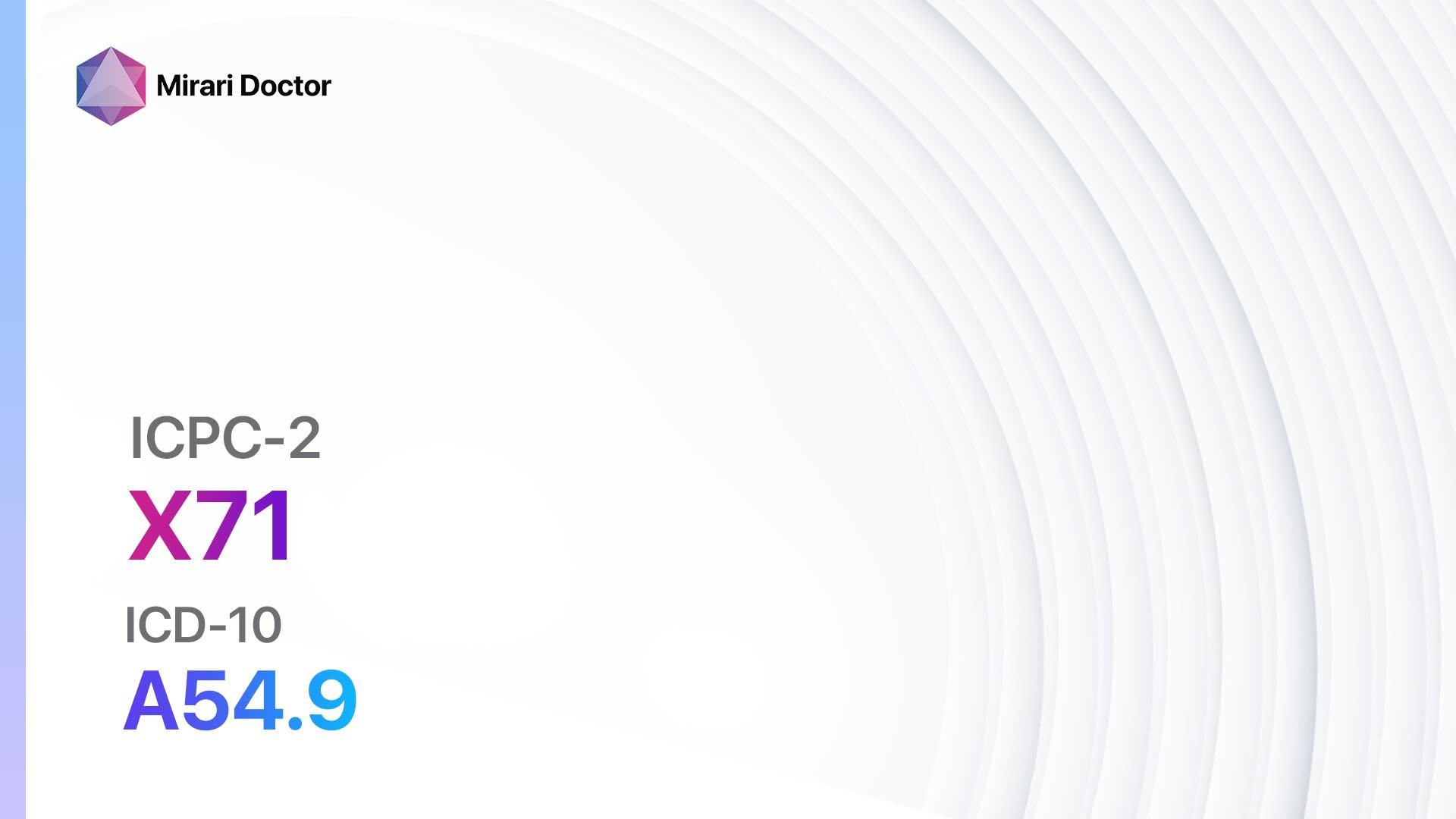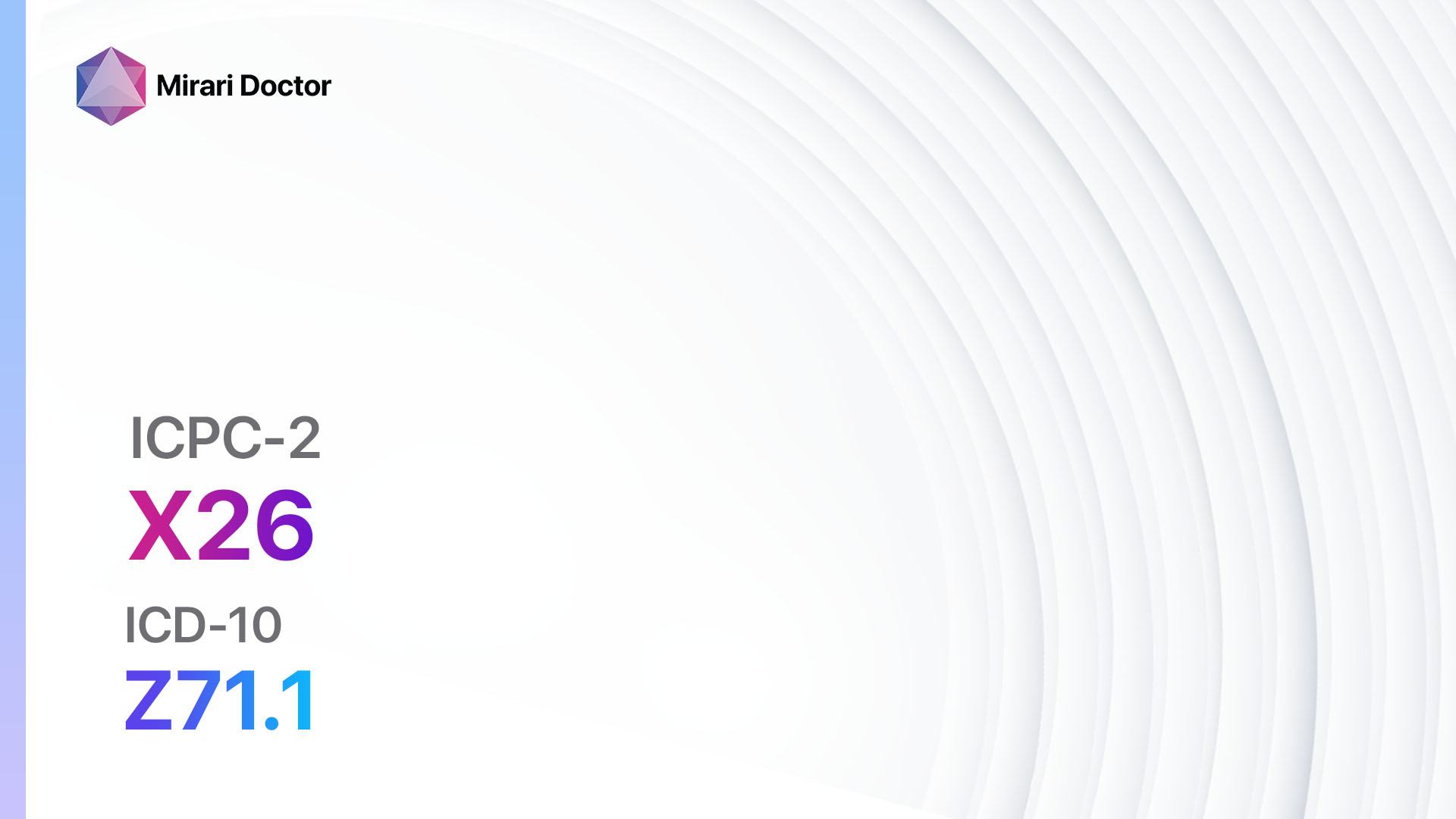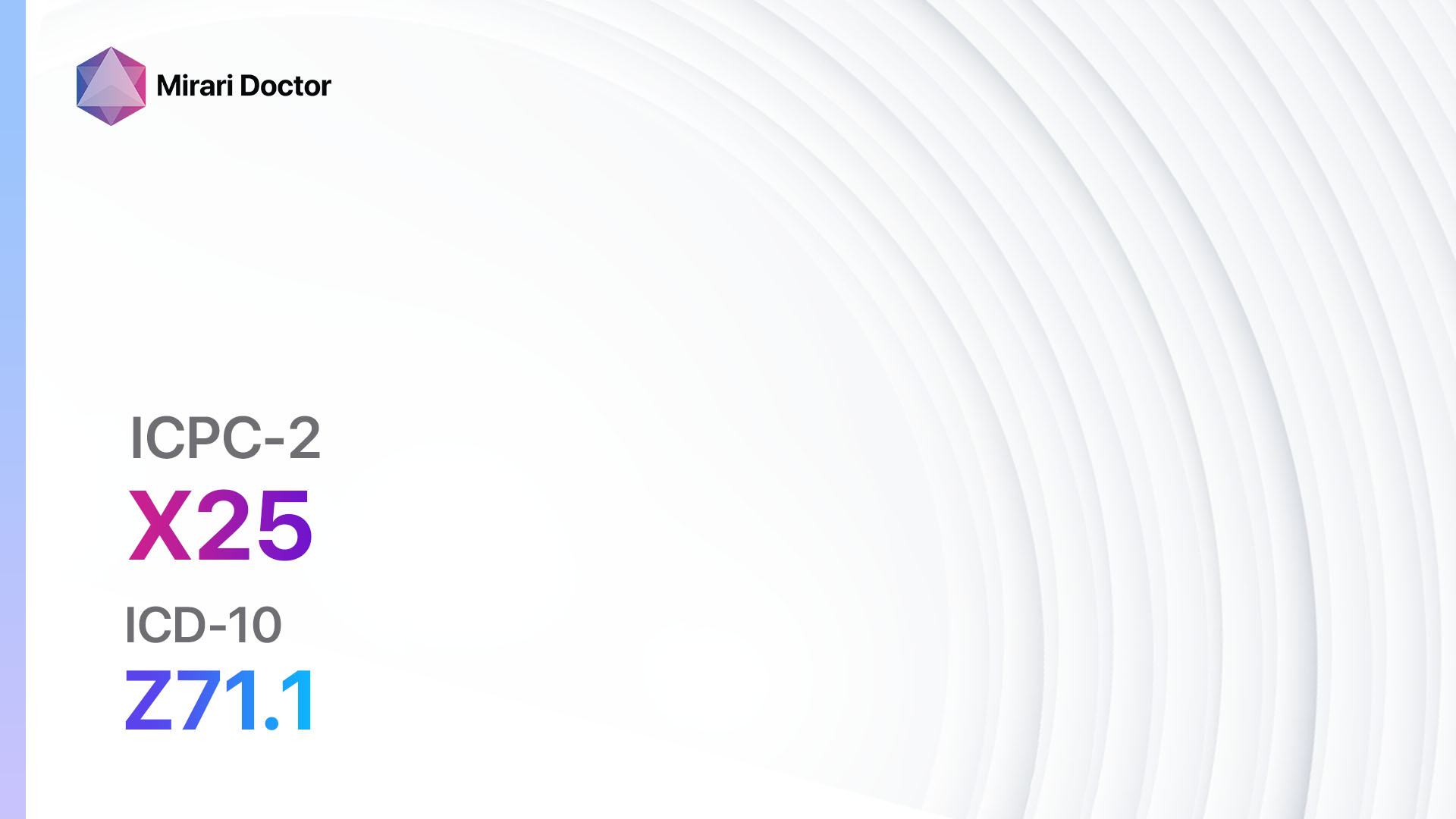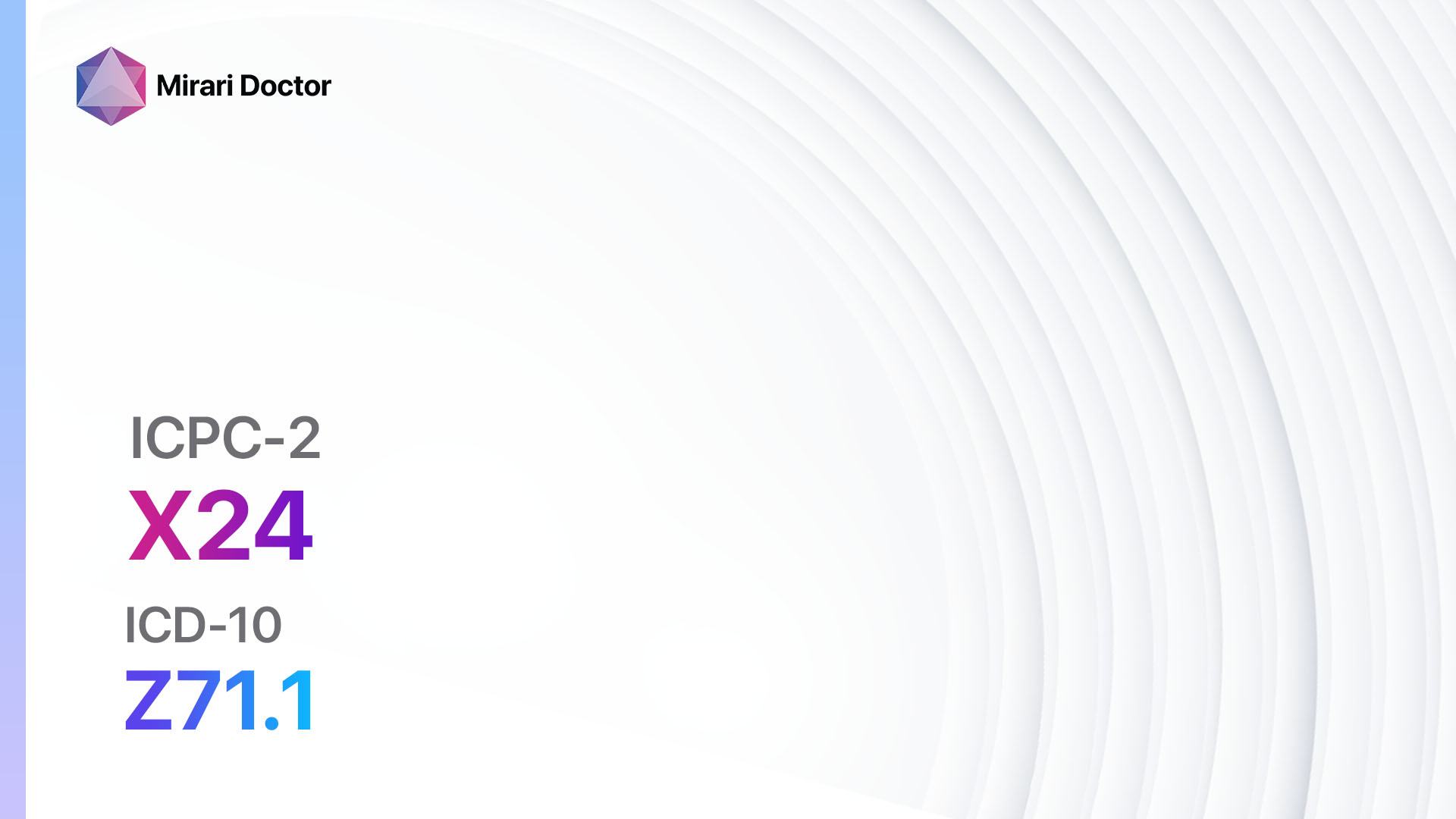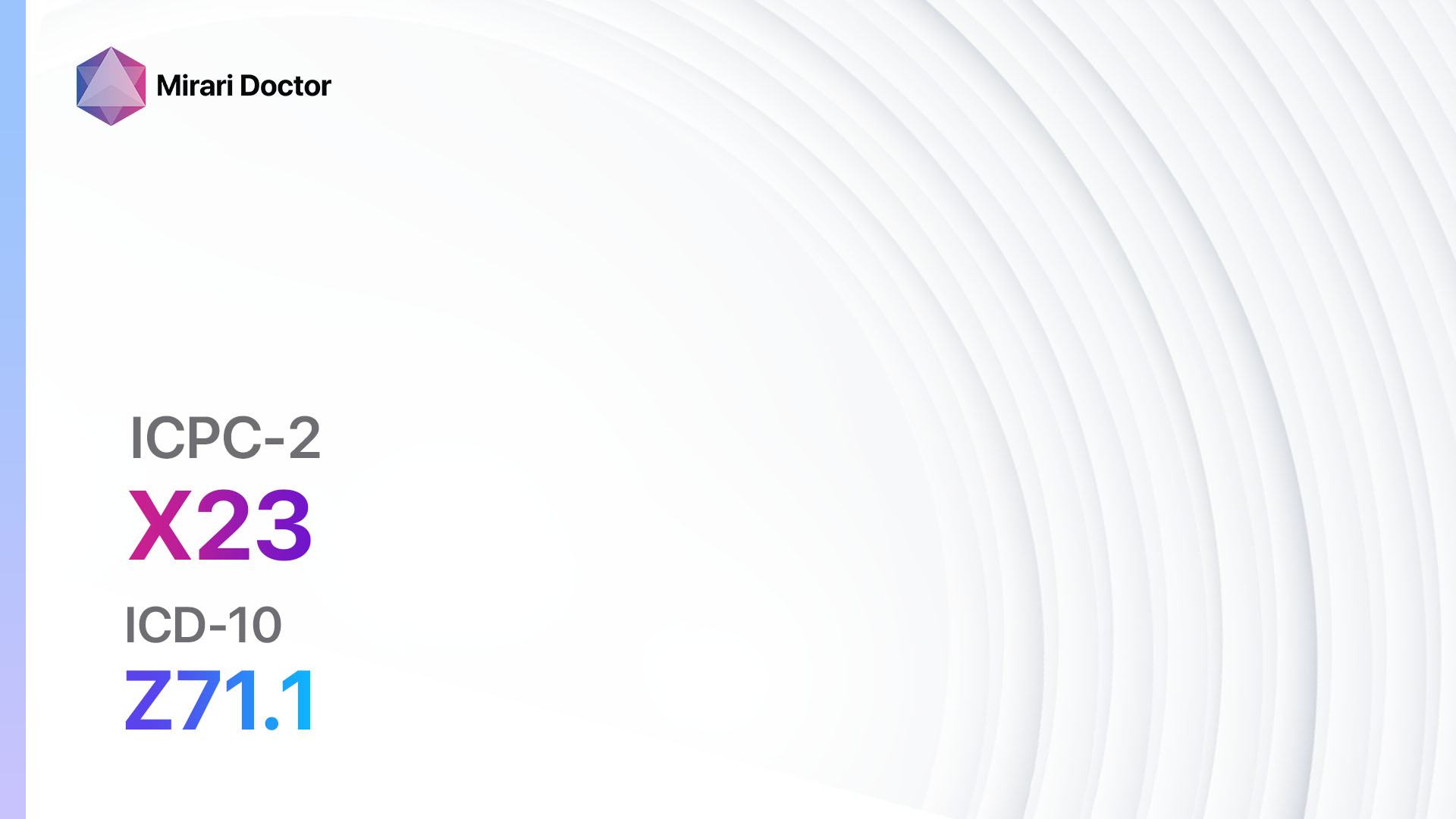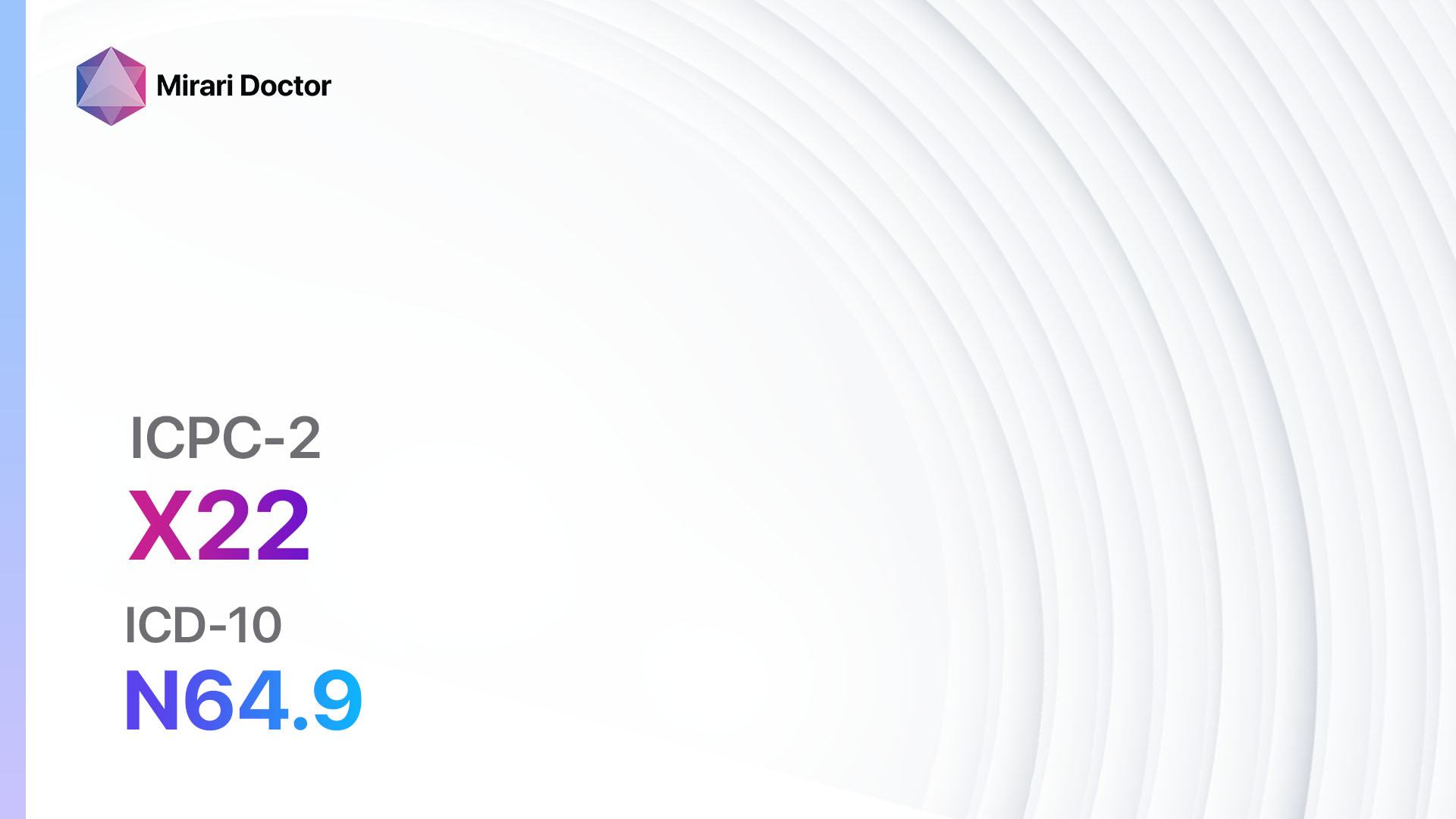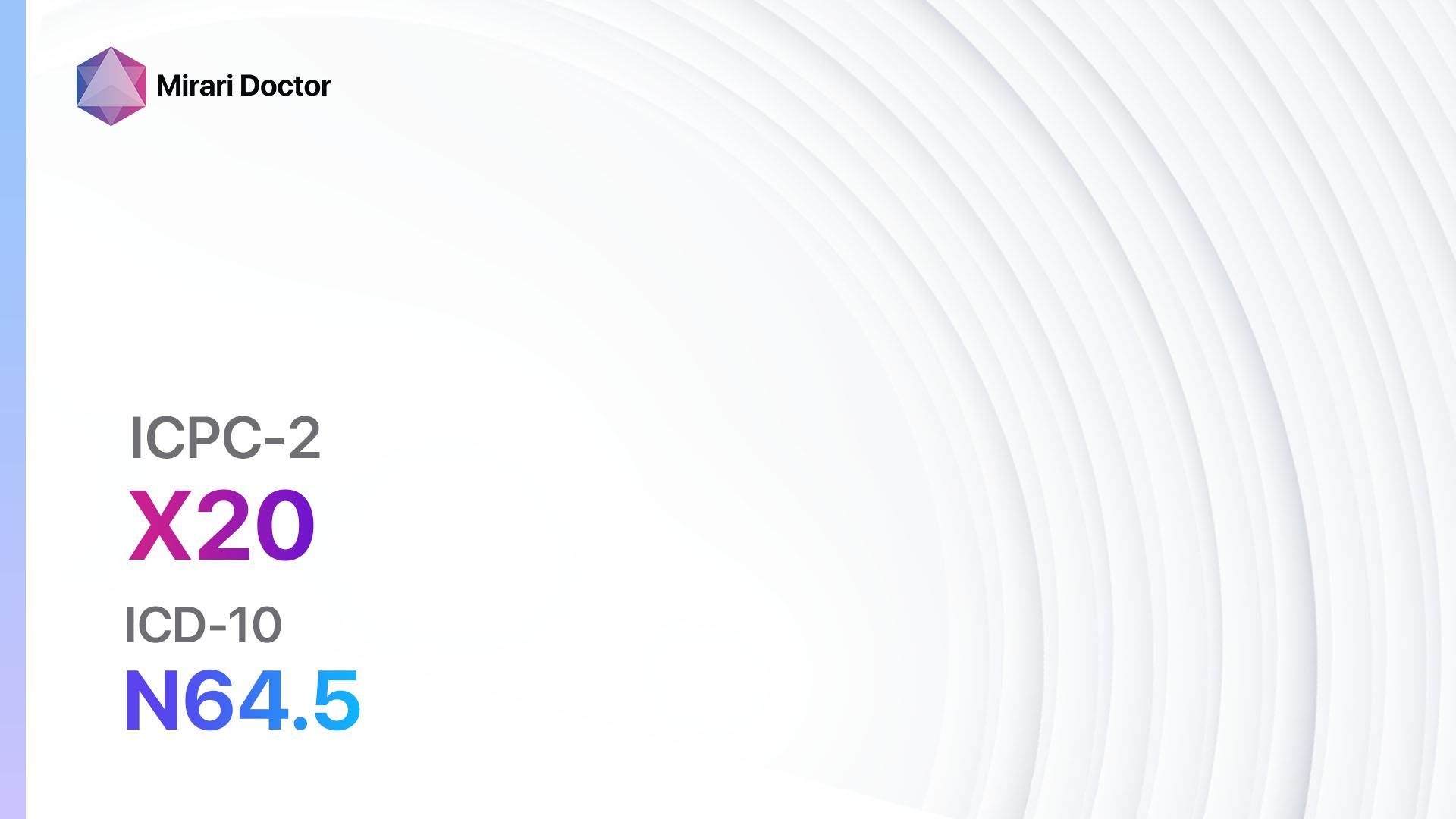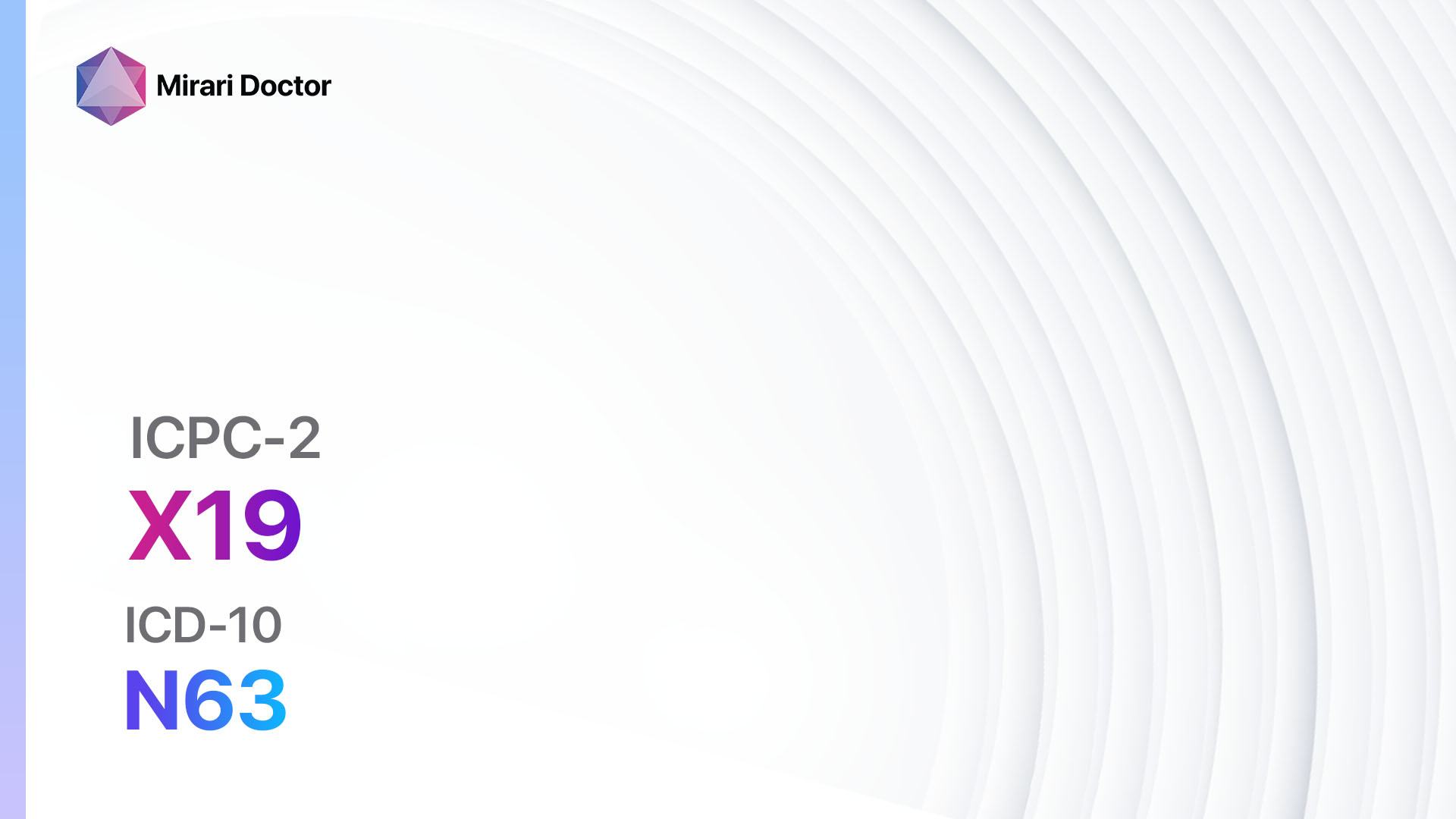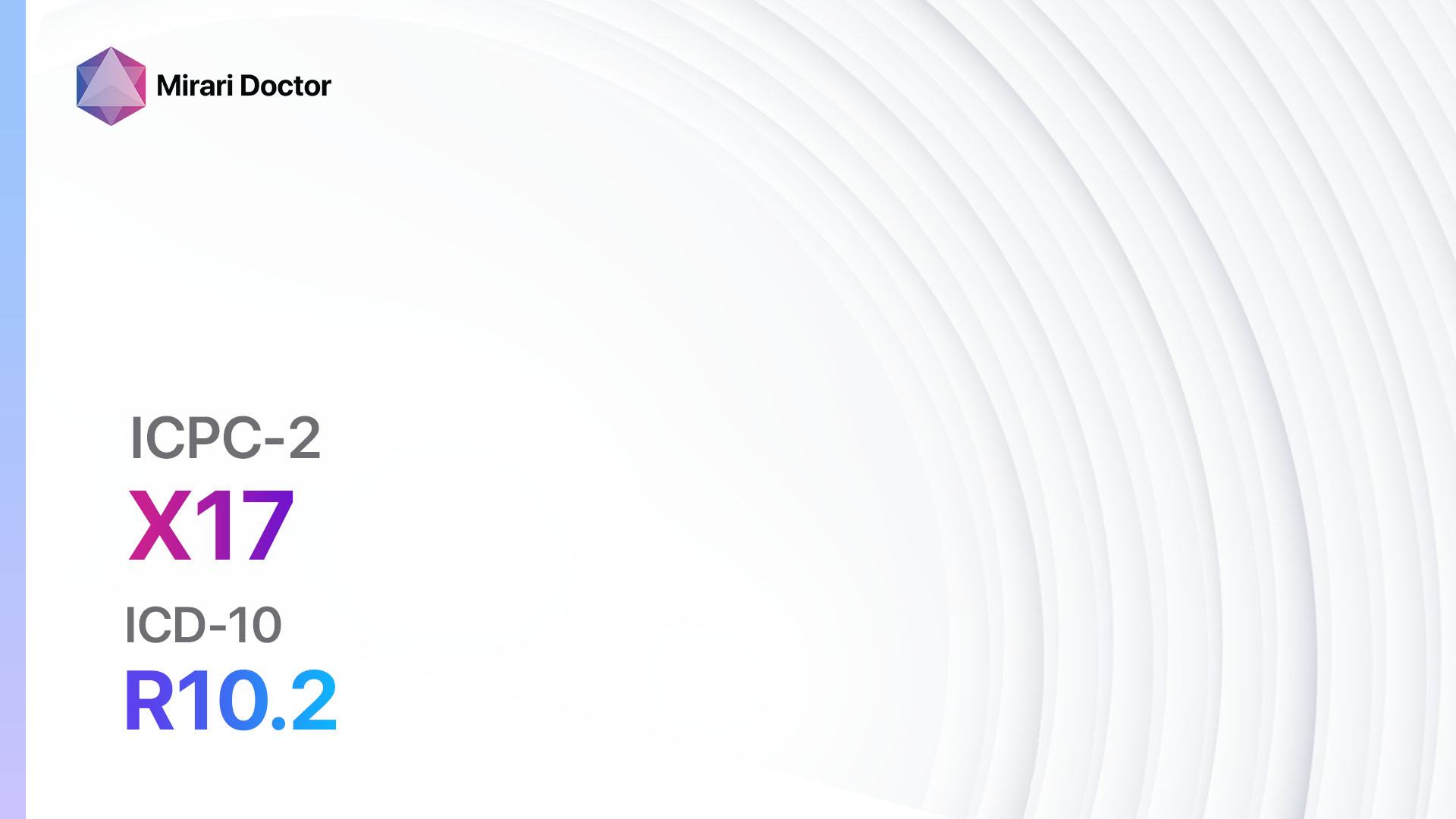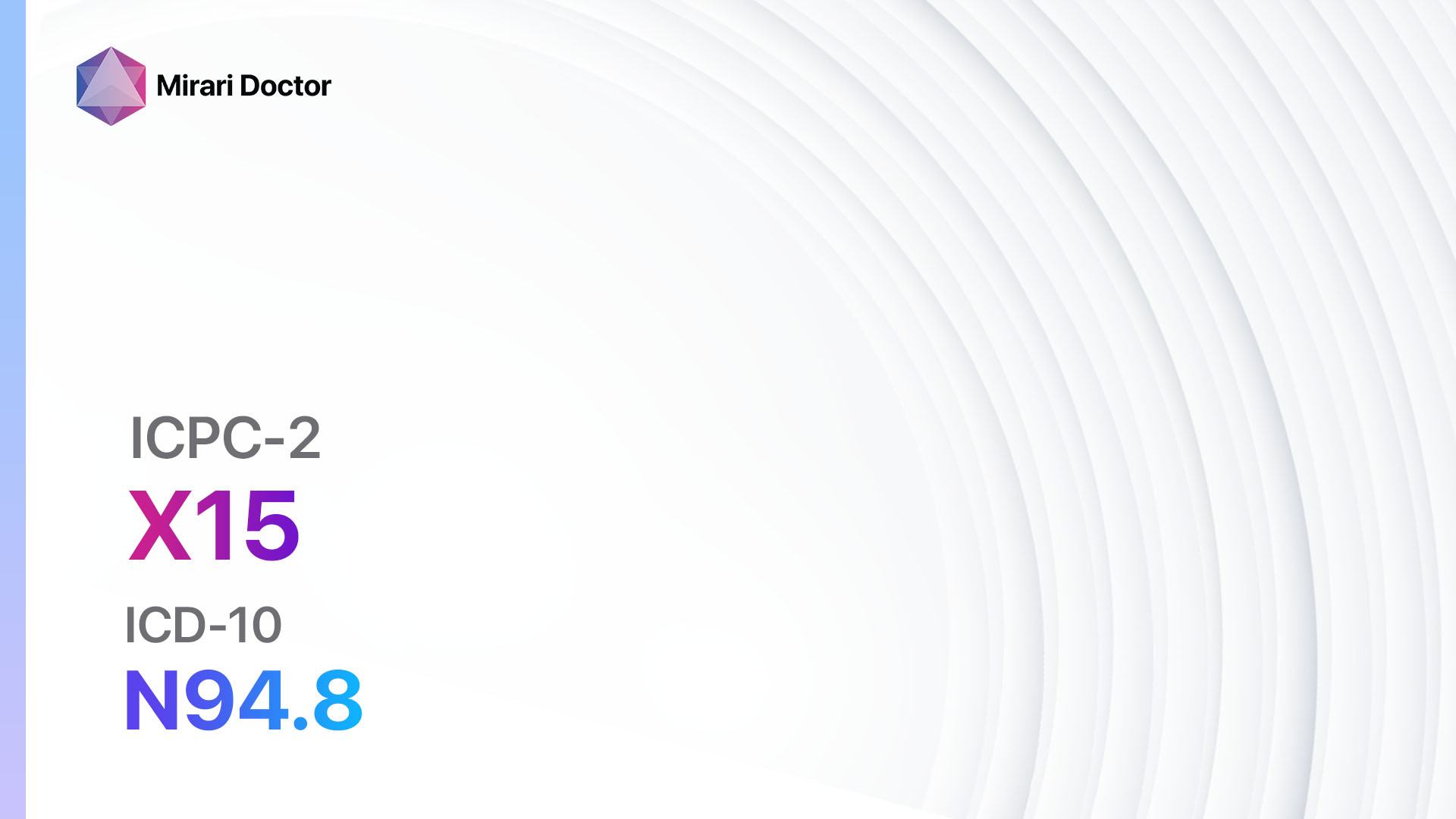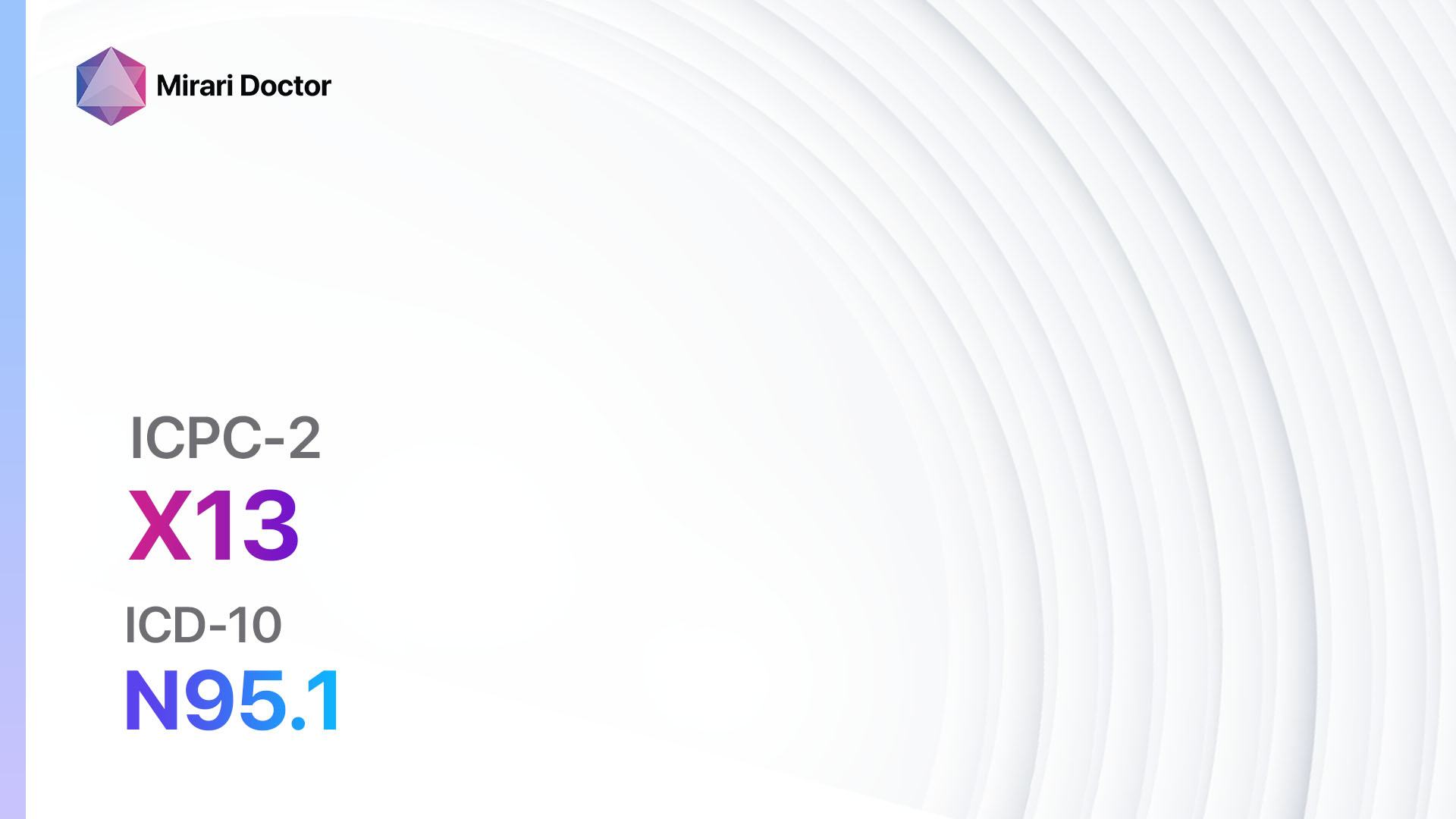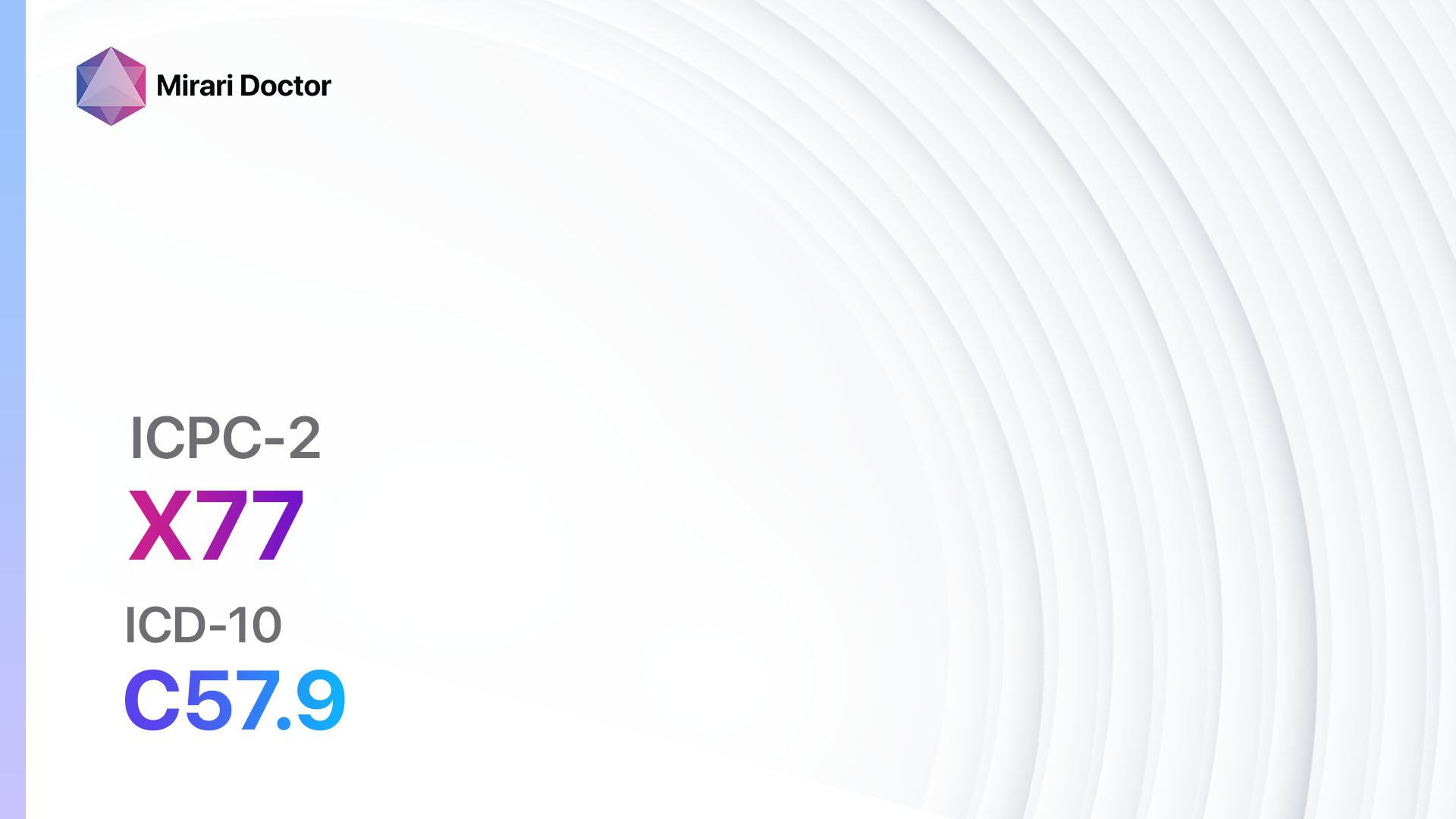
Introduction
Malignant neoplasm genital other (f) refers to a type of cancer that affects the female genital organs other than the cervix, uterus, and ovaries[1]. This guide aims to provide information on the symptoms, causes, diagnostic steps, possible interventions, and lifestyle interventions for this condition.
Codes
- ICPC-2 Code: X77 Malignant neoplasm genital female other[2]
- ICD-10 Code: C57.9 Malignant neoplasm of female genital organ, unspecified[3]
Symptoms
- Abnormal vaginal bleeding[4]
- Vaginal discharge[4]
- Pelvic pain or discomfort[4]
- Pain during sexual intercourse[4]
- Changes in the appearance of the vulva or vagina[4]
Causes
The exact causes of malignant neoplasm genital other (f) are not fully understood. However, certain factors may increase the risk of developing this condition, including:
- Human papillomavirus (HPV) infection[5]
- Smoking[6]
- Weakened immune system[7]
- Personal or family history of genital cancer[8]
- Exposure to certain chemicals or toxins[9]
Diagnostic Steps
Medical History
- Gather information about the patient’s risk factors, such as HPV infection, smoking history, and family history of genital cancer[10].
- Inquire about any symptoms related to malignant neoplasm genital other (f), such as abnormal vaginal bleeding, pelvic pain, or changes in the appearance of the vulva or vagina[10]
Physical Examination
- Perform a thorough physical examination of the genital area, including the vulva, vagina, and cervix.
- Look for any visible abnormalities, such as lumps, sores, or changes in color or texture.
Laboratory Tests
- Pap smear: A sample of cells is collected from the cervix and examined under a microscope to detect any abnormal changes.
- HPV DNA test: This test checks for the presence of high-risk HPV strains that are associated with an increased risk of genital cancer.
- Biopsy: A small sample of tissue is taken from the affected area and examined under a microscope to confirm the presence of cancer cells.
Diagnostic Imaging
- Pelvic ultrasound: This imaging test uses sound waves to create images of the pelvic organs and can help identify any abnormalities.
- Magnetic resonance imaging (MRI): This imaging technique uses a magnetic field and radio waves to create detailed images of the pelvic area, providing more information about the extent of the cancer.
Other Tests
- Colposcopy: A procedure that uses a special magnifying instrument called a colposcope to examine the cervix, vagina, and vulva in more detail.
- Cystoscopy: A thin, flexible tube with a camera is inserted into the urethra to examine the bladder for any signs of cancer.
- Proctoscopy: A similar procedure to cystoscopy, but it is used to examine the rectum and lower part of the colon.
Follow-up and Patient Education
- Schedule regular follow-up appointments to monitor the patient’s condition and response to treatment.
- Provide education on the importance of regular screenings, such as Pap smears and HPV vaccinations, to prevent or detect genital cancer at an early stage.
Possible Interventions
Traditional Interventions
Medications:
Top 5 drugs for Malignant neoplasm genital other (f):
- Chemotherapy drugs (e.g., Paclitaxel, Cisplatin):
- Cost: The cost of chemotherapy drugs can vary widely depending on the specific drugs used and the treatment regimen. It can range from several hundred to several thousand dollars per cycle.
- Contraindications: Allergy to the drug, severe kidney or liver disease.
- Side effects: Nausea, vomiting, hair loss, fatigue.
- Severe side effects: Bone marrow suppression, kidney damage.
- Drug interactions: Many chemotherapy drugs have potential interactions with other medications. It is important to consult with a healthcare provider or pharmacist.
- Warning: Chemotherapy drugs can cause significant side effects and require close monitoring by a healthcare team.
- Targeted therapy (e.g., Bevacizumab, Trastuzumab):
- Cost: The cost of targeted therapy drugs can vary widely depending on the specific drugs used and the treatment regimen. It can range from several thousand to tens of thousands of dollars per cycle.
- Contraindications: Allergy to the drug, severe heart disease.
- Side effects: Fatigue, high blood pressure, rash.
- Severe side effects: Heart problems, bleeding.
- Drug interactions: Many targeted therapy drugs have potential interactions with other medications. It is important to consult with a healthcare provider or pharmacist.
- Warning: Targeted therapy drugs are designed to specifically target cancer cells but can also affect normal cells in the body.
- Hormone therapy (e.g., Tamoxifen, Letrozole):
- Cost: The cost of hormone therapy drugs can vary widely depending on the specific drugs used and the treatment regimen. It can range from several hundred to several thousand dollars per month.
- Contraindications: Allergy to the drug, history of blood clots.
- Side effects: Hot flashes, mood changes, vaginal dryness.
- Severe side effects: Blood clots, endometrial cancer.
- Drug interactions: Many hormone therapy drugs have potential interactions with other medications. It is important to consult with a healthcare provider or pharmacist.
- Warning: Hormone therapy drugs are used to block or reduce the effects of hormones on cancer cells.
- Immunotherapy (e.g., Pembrolizumab, Nivolumab):
- Cost: The cost of immunotherapy drugs can vary widely depending on the specific drugs used and the treatment regimen. It can range from several thousand to tens of thousands of dollars per cycle.
- Contraindications: Allergy to the drug, autoimmune diseases.
- Side effects: Fatigue, skin rash, diarrhea.
- Severe side effects: Severe allergic reactions, inflammation of organs.
- Drug interactions: Many immunotherapy drugs have potential interactions with other medications. It is important to consult with a healthcare provider or pharmacist.
- Warning: Immunotherapy drugs work by stimulating the body’s immune system to fight cancer cells.
- Radiation therapy:
- Cost: The cost of radiation therapy can vary widely depending on the treatment regimen and the number of sessions required. It can range from several thousand to tens of thousands of dollars.
- Contraindications: Pregnancy, certain medical conditions that make radiation therapy unsafe.
- Side effects: Fatigue, skin changes, nausea.
- Severe side effects: Damage to nearby organs, secondary cancers.
- Drug interactions: Radiation therapy does not have direct drug interactions, but it may interact with certain medications used to manage side effects.
- Warning: Radiation therapy uses high-energy radiation to kill cancer cells and requires careful planning and monitoring by a radiation oncologist.
Alternative Drugs:
- Herbal supplements: Some herbal supplements, such as green tea extract and curcumin, have shown potential anticancer effects. However, their effectiveness and safety in treating genital cancer are not well-established. It is important to consult with a healthcare provider before using any herbal supplements.
Surgical Procedures:
- Surgery: Surgical options for malignant neoplasm genital other (f) may include:
- Excision of the tumor: Removal of the cancerous tissue.
- Lymph node dissection: Removal of nearby lymph nodes to determine if the cancer has spread.
- Radical hysterectomy: Removal of the uterus, cervix, and surrounding tissues.
- Pelvic exenteration: Removal of the uterus, cervix, vagina, bladder, rectum, and surrounding tissues in advanced cases.
- Cost: The cost of surgical procedures can vary widely depending on the complexity of the surgery, the hospital, and other factors. It can range from several thousand to tens of thousands of dollars.
Alternative Interventions
- Acupuncture: May help manage symptoms such as pain and nausea. Cost: $60-$120 per session.
- Meditation and relaxation techniques: Can help reduce stress and improve overall well-being. Cost: Free to minimal cost.
- Nutritional therapy: A balanced diet rich in fruits, vegetables, and whole grains can support overall health and well-being. Cost: Varies depending on food choices.
- Supportive care: Counseling, support groups, and palliative care can provide emotional and physical support throughout the treatment process. Cost: Varies depending on the specific services and healthcare provider.
Lifestyle Interventions
- Smoking cessation: Quitting smoking can reduce the risk of developing genital cancer and improve treatment outcomes. Cost: Varies depending on the method used, such as nicotine replacement therapy or medications.
- Healthy diet and exercise: Maintaining a healthy weight and engaging in regular physical activity can support overall health and well-being. Cost: Varies depending on food choices and exercise preferences.
- Safe sexual practices: Practicing safe sex, including using condoms and getting regular screenings for sexually transmitted infections, can reduce the risk of HPV infection. Cost: Varies depending on the availability and cost of condoms and STI screenings.
- Regular screenings: Regular screenings, such as Pap smears and HPV vaccinations, can help detect genital cancer at an early stage or prevent it altogether. Cost: Varies depending on healthcare coverage and access to screenings.
It is important to note that the cost ranges provided are approximate and may vary depending on the location and availability of the interventions. It is recommended to consult with a healthcare provider or insurance provider for more accurate cost information.
Mirari Cold Plasma Alternative Intervention
Understanding Mirari Cold Plasma
- Safe and Non-Invasive Treatment: Mirari Cold Plasma is a safe and non-invasive treatment option for various skin conditions. It does not require incisions, minimizing the risk of scarring, bleeding, or tissue damage.
- Efficient Extraction of Foreign Bodies: Mirari Cold Plasma facilitates the removal of foreign bodies from the skin by degrading and dissociating organic matter, allowing easier access and extraction.
- Pain Reduction and Comfort: Mirari Cold Plasma has a local analgesic effect, providing pain relief during the treatment, making it more comfortable for the patient.
- Reduced Risk of Infection: Mirari Cold Plasma has antimicrobial properties, effectively killing bacteria and reducing the risk of infection.
- Accelerated Healing and Minimal Scarring: Mirari Cold Plasma stimulates wound healing and tissue regeneration, reducing healing time and minimizing the formation of scars.
Mirari Cold Plasma Prescription
Video instructions for using Mirari Cold Plasma Device – X77 Malignant neoplasm genital female other (ICD-10:C57.9)
| Mild | Moderate | Severe |
| Mode setting: 1 (Infection) Location: 0 (Localized) Morning: 15 minutes, Evening: 15 minutes |
Mode setting: 1 (Infection) Location: 0 (Localized) Morning: 30 minutes, Lunch: 30 minutes, Evening: 30 minutes |
Mode setting: 1 (Infection) Location: 0 (Localized) Morning: 30 minutes, Lunch: 30 minutes, Evening: 30 minutes |
| Mode setting: 2 (Wound Healing) Location: 0 (Localized) Morning: 15 minutes, Evening: 15 minutes |
Mode setting: 2 (Wound Healing) Location: 0 (Localized) Morning: 30 minutes, Lunch: 30 minutes, Evening: 30 minutes |
Mode setting: 2 (Wound Healing) Location: 0 (Localized) Morning: 30 minutes, Lunch: 30 minutes, Evening: 30 minutes |
| Mode setting: 2 (Wound Healing) Location: 0 (Localized) Morning: 15 minutes, Evening: 15 minutes |
Mode setting: 2 (Wound Healing) Location: 0 (Localized) Morning: 30 minutes, Lunch: 30 minutes, Evening: 30 minutes |
Mode setting: 2 (Wound Healing) Location: 0 (Localized) Morning: 30 minutes, Lunch: 30 minutes, Evening: 30 minutes |
| Mode setting: 7 (Immunotherapy) Location: 1 (Sacrum) Morning: 15 minutes, Evening: 15 minutes |
Mode setting: 7 (Immunotherapy) Location: 1 (Sacrum) Morning: 30 minutes, Lunch: 30 minutes, Evening: 30 minutes |
Mode setting: 7 (Immunotherapy) Location: 1 (Sacrum) Morning: 30 minutes, Lunch: 30 minutes, Evening: 30 minutes |
| Total Morning: 60 minutes approx. $10 USD, Evening: 60 minutes approx. $10 USD |
Total Morning: 120 minutes approx. $20 USD, Lunch: 120 minutes approx. $20 USD, Evening: 120 minutes approx. $20 USD, |
Total Morning: 120 minutes approx. $20 USD, Lunch: 120 minutes approx. $20 USD, Evening: 120 minutes approx. $20 USD, |
| Usual treatment for 7-60 days approx. $140 USD – $1200 USD | Usual treatment for 6-8 weeks approx. $2,520 USD – $3,360 USD |
Usual treatment for 3-6 months approx. $5,400 USD – $10,800 USD
|
 |
|
Use the Mirari Cold Plasma device to treat Malignant neoplasm genital other (f) effectively.
WARNING: MIRARI COLD PLASMA IS DESIGNED FOR THE HUMAN BODY WITHOUT ANY ARTIFICIAL OR THIRD PARTY PRODUCTS. USE OF OTHER PRODUCTS IN COMBINATION WITH MIRARI COLD PLASMA MAY CAUSE UNPREDICTABLE EFFECTS, HARM OR INJURY. PLEASE CONSULT A MEDICAL PROFESSIONAL BEFORE COMBINING ANY OTHER PRODUCTS WITH USE OF MIRARI.
Step 1: Cleanse the Skin
- Start by cleaning the affected area of the skin with a gentle cleanser or mild soap and water. Gently pat the area dry with a clean towel.
Step 2: Prepare the Mirari Cold Plasma device
- Ensure that the Mirari Cold Plasma device is fully charged or has fresh batteries as per the manufacturer’s instructions. Make sure the device is clean and in good working condition.
- Switch on the Mirari device using the power button or by following the specific instructions provided with the device.
- Some Mirari devices may have adjustable settings for intensity or treatment duration. Follow the manufacturer’s instructions to select the appropriate settings based on your needs and the recommended guidelines.
Step 3: Apply the Device
- Place the Mirari device in direct contact with the affected area of the skin. Gently glide or hold the device over the skin surface, ensuring even coverage of the area experiencing.
- Slowly move the Mirari device in a circular motion or follow a specific pattern as indicated in the user manual. This helps ensure thorough treatment coverage.
Step 4: Monitor and Assess:
- Keep track of your progress and evaluate the effectiveness of the Mirari device in managing your Malignant neoplasm genital other (f). If you have any concerns or notice any adverse reactions, consult with your health care professional.
Note
This guide is for informational purposes only and should not replace the advice of a medical professional. Always consult with your healthcare provider or a qualified medical professional for personal advice, diagnosis, or treatment. Do not solely rely on the information presented here for decisions about your health. Use of this information is at your own risk. The authors of this guide, nor any associated entities or platforms, are not responsible for any potential adverse effects or outcomes based on the content.
Mirari Cold Plasma System Disclaimer
- Purpose: The Mirari Cold Plasma System is a Class 2 medical device designed for use by trained healthcare professionals. It is registered for use in Thailand and Vietnam. It is not intended for use outside of these locations.
- Informational Use: The content and information provided with the device are for educational and informational purposes only. They are not a substitute for professional medical advice or care.
- Variable Outcomes: While the device is approved for specific uses, individual outcomes can differ. We do not assert or guarantee specific medical outcomes.
- Consultation: Prior to utilizing the device or making decisions based on its content, it is essential to consult with a Certified Mirari Tele-Therapist and your medical healthcare provider regarding specific protocols.
- Liability: By using this device, users are acknowledging and accepting all potential risks. Neither the manufacturer nor the distributor will be held accountable for any adverse reactions, injuries, or damages stemming from its use.
- Geographical Availability: This device has received approval for designated purposes by the Thai and Vietnam FDA. As of now, outside of Thailand and Vietnam, the Mirari Cold Plasma System is not available for purchase or use.
References
- Tien Le, MD, FRCSC, DABOG. Vulvar and vaginal cancer. In: Yarbro, CH, Wujcki D, & Holmes Gobel B. (eds.). Cancer Nursing: Principles and Practice. 7th ed. Sudbury, MA: Jones and Bartlett; 2011: 69: pp. 1719-1739.
- WONCA International Classification Committee. ICPC-2: International Classification of Primary Care. 2nd ed. Oxford: Oxford University Press; 1998.
- World Health Organization. International Statistical Classification of Diseases and Related Health Problems (ICD). 10th Revision. Geneva: World Health Organization; 2019.
- American Cancer Society. Vaginal Cancer. 2018. https://www.cancer.org/cancer/vaginal-cancer/detection-diagnosis-staging/signs-symptoms.html. Accessed April 21, 2023.
- Chaturvedi AK. Beyond cervical cancer: burden of other HPV-related cancers among men and women. J Adolesc Health. 2010;46(4 Suppl):S20-S26. doi:10.1016/j.jadohealth.2010.01.016
- Madsen BS, Jensen HL, van den Brule AJ, Wohlfahrt J, Frisch M. Risk factors for invasive squamous cell carcinoma of the vulva and vagina–population-based case-control study in Denmark. Int J Cancer. 2008;122(12):2827-2834. doi:10.1002/ijc.23446
- Frisch M, Biggar RJ, Goedert JJ. Human papillomavirus-associated cancers in patients with human immunodeficiency virus infection and acquired immunodeficiency syndrome. J Natl Cancer Inst. 2000;92(18):1500-1510. doi:10.1093/jnci/92.18.1500
- Bjørge T, Hennig EM, Skare GB, Søreide O, Thoresen SO. Second primary cancers in patients with carcinoma in situ of the uterine cervix. The Norwegian experience 1970-1992. Int J Cancer. 1995;62(1):29-33. doi:10.1002/ijc.2910620107
- Weiderpass E, Pukkala E. Time trends in socioeconomic differences in incidence rates of cancers of gastro-intestinal tract in Finland. BMC Gastroenterol. 2006;6:41. Published 2006 Nov 30. doi:10.1186/1471-230X-6-41
- PDQ Adult Treatment Editorial Board. Vaginal Cancer Treatment (PDQ®): Health Professional Version. 2022 Mar 4. In: PDQ Cancer Information Summaries [Internet]. Bethesda (MD): National Cancer Institute (US); 2002-. Available from: https://www.ncbi.nlm.nih.gov/books/NBK65801/
Related articles
Made in USA


